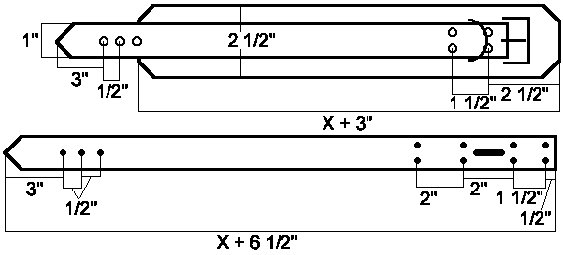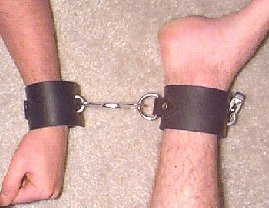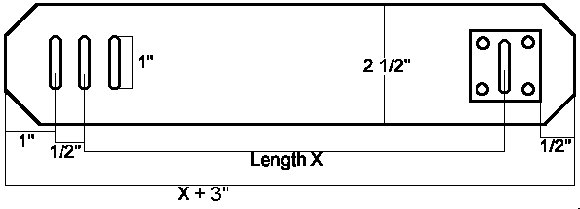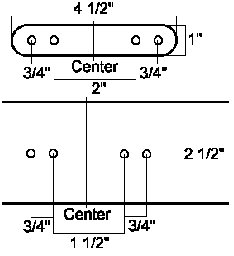 |
| PROJECTS |
| "Locking" & "Buckle Type" Restraints |
| 2 Types of RESTRAINTS that can be made at home. |
| Buckling Restraints Another staple of bondage play, buckling restraints can be just as secure, although not as intimidating, as their locking cousins. One side benefit: you don't have to buy/carry locks or clips to keep them on. The same design can be used for wrist, ankle and thigh restraints, and even collars and belts. The design presented here is only slightly more complex than the locking restraints. With a little ingenuity, you can add a second D-ring to each cuff, roughly opposite the one in the plan and attached using the same 1" strap. Difficulty: Easy Tools Mallet, Utility Knife, Scissors, Square, Rivet Setter, Punch, 1" Oblong Punch, Edge Beveler #2, Edge Slicker, Strap-Cutter (opt.), Grommet Setter and Anvil (opt.) Parts Checklist (per pair) 1" Roller Buckle (2) 1" Welded D-ring (2) Long Rivets or �" Key Posts Grommets (optional) (3+) Leather Checklist (per pair) Base Strap (2): X+3" x 2.5" Belt Strap (2): X+6" x 1" Steps 1 - Measure Measure the circumference of the target location (i.e. measure around the wrist for wrist restraints). Add � to � inch for comfort. Add � to � inch for lining, if desired. This measurement is 'X' in Diagram 1 below. 2 - Cut Leather Cut the two leather straps that form each restraint. The easiest way to do this is to cut 2 �" and 1" straps from a piece of leather using the Strap-Cutter, then cut to size with a Square and Utility Knife. Make sure the ends are square (perpendicular) to the sides. Next, trim each corner of the primary strap and one end of the belt strap. You can use a 1" belt-ender on the belt strap, if you have one. 3 - Punch Securing Holes Following the plan in Diagram 1, punch four holes in the primary strap. The belt strap will be secured to the primary strap through these holes. The size will vary, depending on whether you are using four rivets or key posts to hold everything together. Next punch the eight 'securing' hole in the belt strap, as indicated in Diagram 1. Note that the belt strap will loop back for the last three inches. Using a 1" oblong punch, make the hole for the tong of the buckle. Depending on the width of the tong, you may need to punch this hole 1 � to 2 times as wide as the oblong punch. We'll hold off on the belt holes for now. 4 - Finish Edges Finish the edges before attaching hardware. Use a #X edge beveller to bevel all outer edges, top and bottom, on both straps. Rub all of the outer edges briefly with an edge slicker and apply Edge Coat. Allow to dry, about 15 minutes. 5 - Attach Straps Secure the belt strap to the primary strap using either long rivets or �" key posts. Use key posts for greater strength. Of course, the buckle and D-ring must both be in place during this process. 6 - Punch Belt Holes Punch the belt holes. You can follow the measurements in Diagram 1, but it is better to mark the location for the first hole in place. Put the restraint on the target location, pull the belt strap through the buckle (the buckle-side base strap should go OVER the opposite end), and mark a comfortable location. If you plan on lining the restraint, place one layer of the lining material between the restraint and the target area. 7 - Place Grommets, Optional If desired, you may place grommets in the belt holes. This definitely increases the life of the piece by reducing wear and tear on the belt strap, but does cause the action to be a little rough. Your choice. 8 - Lining, Optional If you want to line your restraints, I recommend either a nice suede or felt. Cut a piece of lining slightly wider and longer than the primary strap. This is the area that will be lined. Lay the lining on a flat surface, with the side to be glued up. Coat the inside of the primary strap liberally with Fabri-Tac. Starting from one end, firmly lay the strap (glue-side down) onto the lining. Press down hard for several seconds. Allow the glue to set, then trim off the excess lining carefully with a pair of scissors. Diagram 1 |
| Locking Restraints The basic staple of secure bondage is a set of locking restraints. One common design can be used for wrist, ankle and thigh restraints, and even collors and belts. The design presented here is simple and fast to make. Difficulty: Easy Tools Mallet, Utility Knife, Scissors, Square, Rivet Setter, Punch, 1" Oblong Punch, Edge Beveler #2, Edge Slicker, Strap-Cutter (optional) Parts Checklist (per pair) Medium Rivets Plate Staple (2) Leather Checklist (per pair) Base Strap (2): X+3" x 2.5" Steps 1.1 - Measure Measure the circumference of the target location (i.e. measure around the wrist for wrist restraints). Add � to � inch for comfort. Add � to � inch for lining, if desired. This measurement is 'X' in Diagram 1 below. 1.2 - Cut Leather Cut the leather straps that form the restraints. The easiest way to do this is to cut a 2 �" strap from a piece of leather using the Strap-Cutter, then cut to size with a Square and Utility Knife. Make sure the ends are square (perpendicular) to the sides. Next, trim each corner. You can either trim off a small triangle as shown, or round slightly with scissors. 1.3 - Punch Plate Staple Holes Four rivets will hold the plate staple to the strap. To make these holes, position the plate staple �" from one end, centered across the strap's width. Mark the position of these holes, remove the plate staple, and punch all four holes into the strap with a Hole Punch. 1.4 - Punch Tongue Holes The hoop of the plate staple will slide through one or more tongue holes in the opposite end. These holes are punched using a 1" Oblong Punch. The positioning of these holes is important for a quality appearance. It is wise to make a template from a scrap of leather, also 2 �" wide, to ensure consistent positioning. Place the template on top of the strap and lightly punch through the template into the second piece. This results in clear marks in your strap. Remove the template and punch the tongue holes the rest of the way through. 1.5 - Finish Edges You are now done working the strap, and should finish the edges before attaching hardware. Use a #X edge beveller to bevel all outer edges, top and bottom. Rub all of the outer edges briefly with an edge slicker and apply Edge Coat. Allow to dry, about 15 minutes. 1.6 - Attach Plate Staple Firmly attach the plate staple with four medium rivets. The rivet base should be on the inside, the cap on the outside. 1.7 - Lining, Optional If you want to line your restraints, I recommend either a nice suede or felt. Cut a piece of lining slightly wider than the strap, and slightly longer than the distance between the plate staple end and the first tongue hole. This is the area that will be lined. Lay the lining on a flat surface, with the side to be glued up. Coat the inside of the strap below the first tongue hole liberally with Fabri-Tac. Starting from the first tongue hole, firmly lay the strap (glue-side down) onto the lining. Press down hard for several seconds. Allow the glue to set, then trim off the excess lining carefully with a pair of scissors. Diagram 1 Adding D-Rings While the loop of the plate staple can be used to lock the restraint to something, as well as on someone, one or more additional D-rings can be a nice addition to the basic restraint described above. Add the following steps to those above. Step 2.1 - Cut D-ring Strap Each additional D-ring requires a small strap of it's own. Diagram 2 shows this strap with a four-hole configuration. You can also use two-hole D-ring straps by ignoring the outer holes and using a length of 3", if this ring won't take a lot of stress. Again, it is nice to use the Strap-Cutter to make a long piece of 1"-wide stock and just lop off the length you need. Cut the corners to the shape of your choice.. this is a good opportunity to use the Belt-Ender if you have one, or just make a point as shown in The Finished Product picture. Step 2.2 - Punch D-ring Holes Punch four holes as shown in Diagram 2 in both the primary strap and D-ring strap. All holes should be made relative to 'Center', the place where you want the D-ring to end up. Note that the holes in the D-ring strap are farther from center than those on the primary strap. This is because the ring has to fit in there, and should be able to move freely. Step 2.3 - Finish D-ring Strap Edges Do the same finish work described above to the D-ring strap, but do not bevel the bottom edges. This allows the piece to sit more naturally on the primary strap. Step 2.4 - Attach D-ring Attach the D-ring strap to the primary strap using four (or two) medium rivets. Obviously, the D-ring itself needs to end up in between! Diagram 2 |

|
| Diagrams are NOT to scale here, but can be downloaded so you can save and/or modify to you needs. |



